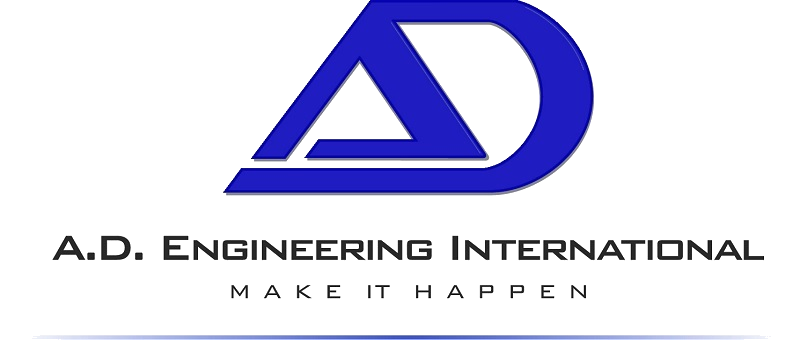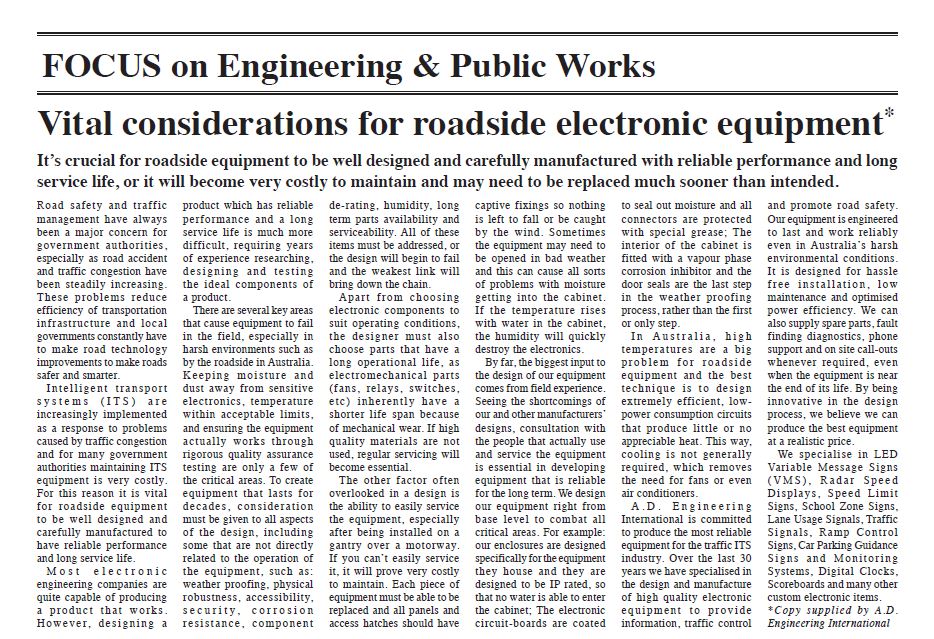It’s crucial for roadside equipment to be well designed and carefully manufactured with reliable performance and long service life, or it will become very costly to maintain and may need to be replaced much sooner than intended.
(Article published in the Local Government Focus Newspaper – Engineering & Public Works feature, April/15 edition)
Road safety and traffic management have always been a major concern for government authorities, especially as road accident and traffic congestion have been steadily increasing. These problems reduce efficiency of transportation infrastructure and local governments constantly have to make road technology improvements to make roads safer and smarter.
Intelligent transport systems (ITS) are increasingly implemented as a response to problems caused by traffic congestion and for many government authorities maintaining ITS equipment is very costly. For this reason it is vital for roadside equipment to be well designed and carefully manufactured to have reliable performance and long service life.
Most electronic engineering companies are quite capable of producing a product that works. However, designing a product which has reliable performance and a long service life is much more difficult, requiring years of experience researching, designing and testing the ideal components of a product.
There are several key areas that cause equipment to fail in the field, especially in harsh environments such as by the roadside in Australia. Keeping moisture and dust away from sensitive electronics, temperature within acceptable limits, and ensuring the equipment actually works through rigorous quality assurance testing are only a few of the critical areas. To create equipment that lasts for decades, consideration must be given to all aspects of the design, including some that are not directly related to the operation of the equipment, such as: weather proofing, physical robustness, accessibility, security, corrosion resistance, component de-rating, humidity, long term parts availability and serviceability. All of these items must be addressed, or the design will begin to fail and the weakest link will bring down the chain.
Apart from choosing electronic components to suit operating conditions, the designer must also choose parts that have a long operational life, as electromechanical parts (fans, relays, switches, etc) inherently have a shorter life span because of mechanical wear. If high quality materials are not used, regular servicing will become essential.
The other factor often overlooked in a design is the ability to easily service the equipment, especially after being installed on a gantry over a motorway. If you can’t easily service it, it will prove very costly to maintain. Each piece of equipment must be able to be replaced and all panels and access hatches should have captive fixings so nothing is left to fall or be caught by the wind. Sometimes the equipment may need to be opened in bad weather and this can cause all sorts of problems with moisture getting into the cabinet. If the temperature rises with water in the cabinet, the humidity will quickly destroy the electronics.
By far, the biggest input to the design of our equipment comes from field experience. Seeing the shortcomings of our and other manufacturers’ designs, consultation with the people that actually use and service the equipment is essential in developing equipment that is reliable for the long term. We design our equipment right from base level to combat all critical areas. For example: our enclosures are designed specifically for the equipment they house and they are designed to be IP rated, so that no water is able to enter the cabinet; The electronic circuit-boards are coated to seal out moisture and all connectors are protected with special grease; The interior of the cabinet is fitted with a vapour phase corrosion inhibitor and the door seals are the last step in the weather proofing process, rather than the first or only step.
In Australia, high temperatures are a big problem for roadside equipment and the best technique is to design extremely efficient, low-power consumption circuits that produce little or no appreciable heat. This way, cooling is not generally required, which removes the need for fans or even air conditioners.
A.D. Engineering International is committed to producing the most reliable equipment for the traffic ITS industry. Over the last 30 years we have specialised in the design and manufacture of high quality electronic equipment to provide information, traffic control and promote road safety. Our equipment is engineered to last and work reliably even in Australia’s harsh environmental conditions. It is designed for hassle free installation, low maintenance and optimised power efficiency. We can also supply spare parts, fault finding diagnostics, phone support and on site call-outs whenever required, even when the equipment is near the end of its life. By being innovative in the design process, we believe we can produce the best equipment at a realistic price.
We specialise in LED Signs, Variable Message Signs VMS (Transportable, Pole or Gantry mounted), Radar Speed Displays, Speed Limit Signs, School Zone Signs, Lane Usage Signals, Traffic Signals, Ramp Control Signs, Car Parking Guidance Signs and Monitoring Systems, Digital Clocks, Scoreboards and many other custom electronic items.





